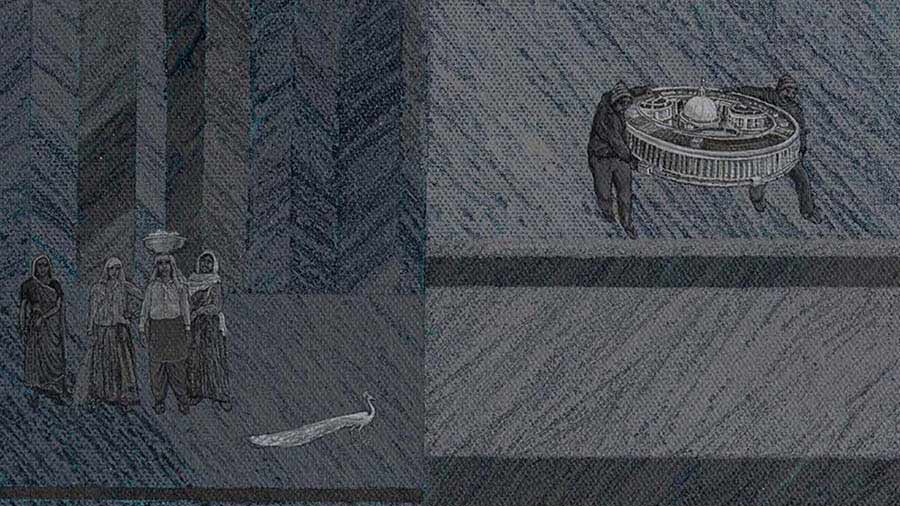February 7 was the final day of the international symposium by the Centre of International Modern Art (CIMA) and Ashoka University, titled Imaginations – Rural, Urban and Global. The day bore witness to four enjoyable and informative sessions among the participants, all of whom joined the discussions from different parts of the country and the world. The constraints caused by the pandemic ensured that the two-day symposium would be a virtual one, but the online space lent itself splendidly to the nature and dynamism of the subjects for each session.
Ideological warfare’s challenges to creativity
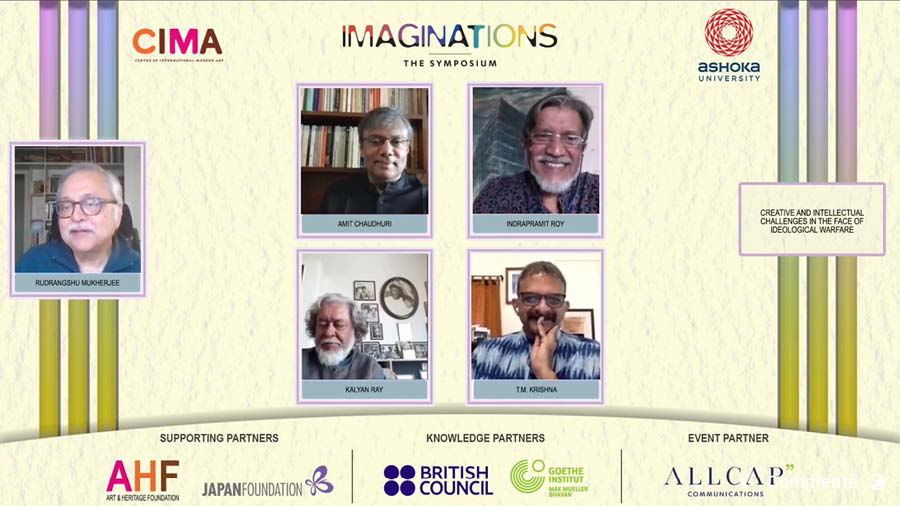
Rudrangshu Mukherjee, chancellor of Ashoka University, in conversation with the panellists of the session, ‘Creative and Intellectual Challenges in the Face of Ideological Warfare’
The first session, titled Creative and Intellectual Challenges in the Face of Ideological Warfare, focused on the growing global threat to an essential component of democracy – namely creative freedom – and the impact it has on the quality of artistic output. The overarching question of the session thus became, how does one combat the forces of ideological warfare? The historian and chancellor of Ashoka University, Rudrangshu Mukherjee, moderated the session, for which the author, musician and professor of creative writing at Ashoka University, Amit Chaudhuri, was the first speaker.
“I’ve noticed over the last couple of months that waking up each morning has not been a pleasure,” he said. “I had a sense of nothing to look forward to. I put it down to the pandemic and what it’s done to our lives, the kind of government we have, and the fact that it has so many counterparts in other parts of the world. I realised this feeling also has to do with the fact that there’s nothing new happening in the realm of creativity. It became clear to me how important a sense of ongoing creativity is to our sense of hope when we get up in the morning. What do the arts do for us and to us? The arts remind us that the justification of one’s existence lies in play, and the possibility of this helps us to get up in the morning. That possibility, unfortunately, seems foreclosed now.”

‘We Shall Witness the Day That Has Been Promised’ by Puja Mondal, graduate, The Maharaja Sayajirao University, Vadodara. It was shown as part of a presentation by Indrapramit Roy, during the first session of Day 2
Responding to this sentiment with an interesting perspective was Indrapramit Roy, associate professor, Faculty of Fine Arts, The Maharaja Sayajirao University, Vadodara. “Ideological warfare manifests in many ways. One is censorship; another is the system of education that emphasises quantification and productivity. These are tools for measuring effectiveness borrowed from more mainstream subjects; they are detrimental to artists. Ideological warfare is an ongoing process; dissent is now actively discouraged. What can art do in that? Well, art can also be surprisingly resilient in crisis as it finds ways to voice dissent.”
“How does the artist involve himself into every aspect of what he is creating?” wondered Kalyan Ray, author and a former professor of English literature in the United States. “What is the politics of it? One can look at a work of art, and it can affect you in very different ways. For instance, the famous image of the Chinese artist, Ai Weiwei, showing the finger at Beijing’s Tiananmen Square in 1995 has inspired a lot of artists on social media and otherwise. Silence often speaks very loudly.”
Taking the discussion in a whole new direction was the last speaker of the session, the Carnatic singer, activist and author, T.M. Krishna. “Ideological warfare is a perpetual state, and whether it stems from concerns of caste, economics or gender, we tend to notice it only when it affects us. There are worlds of art that have always resisted ideological warfare; but art itself can also be an oppressive tool, and artists also oppress. They shut out other voices through their own art and create homogeneity.”
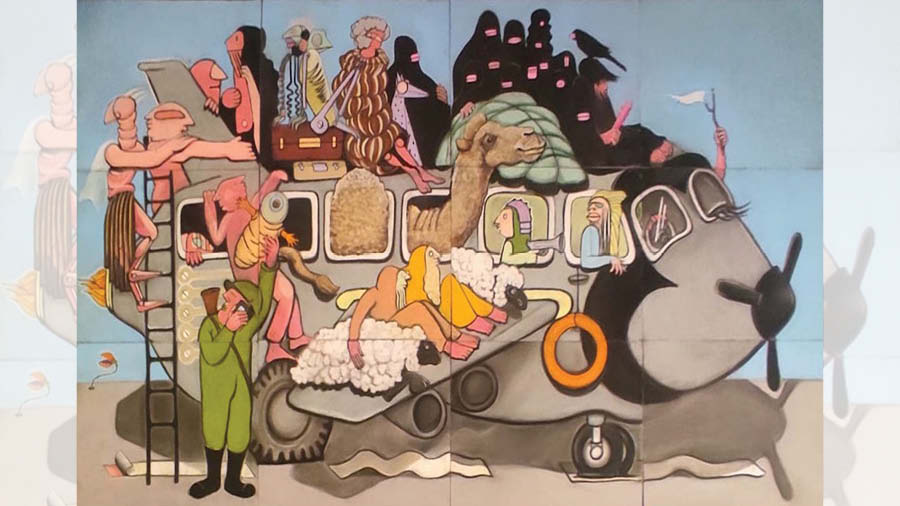
Artwork by Siddhartha Kararwal, graduate, The Maharaja Sayajirao University, Vadodara – shown as part of Indrapramit Roy's presentation
“So as such, the artist is often caught on the cusp of being the victim and sometimes even the oppressor,” concluded Mukherjee, ending with a variation on one of Chaudhuri’s earlier observations – “conversations like this one make getting up in the morning worth it.”
Watch the first session here.
Art and technology
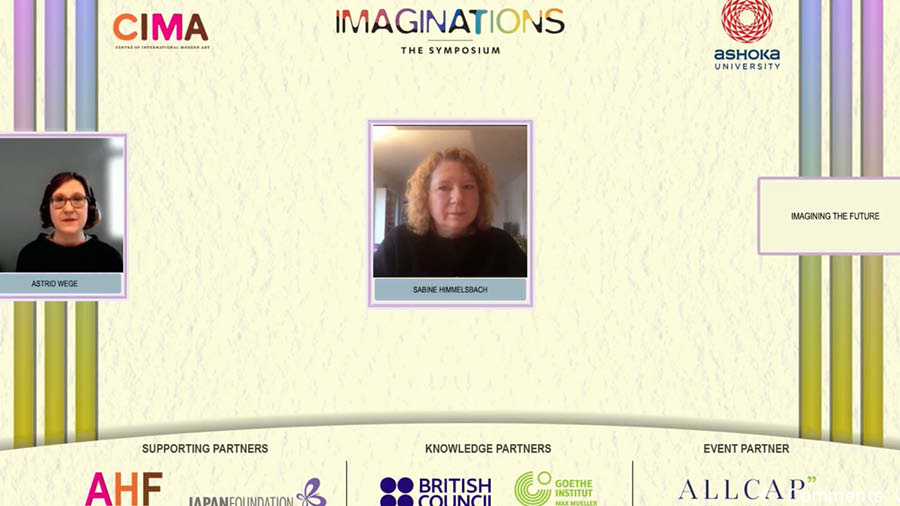
Astrid Wege, the director of the Goethe-Institut / Max Mueller Bhavan in Kolkata, moderates a session with Sabine Himmelsbach, the director of HEK (House of Electronic Arts), Basel, Switzerland, on ‘Imagining the Future’
Next was a deeply engaging lecture by Sabine Himmelsbach, the director of HEK (House of Electronic Arts), Basel, Switzerland, whose session, Imagining the Future, was moderated by Astrid Wege, the director of the Goethe-Institut / Max Mueller Bhavan in Kolkata. Focusing on the ways in which art and science have intersected over the course of history, the conversation reflected on the relationship between new technologies and artistic production. “New media art requires media literacy,” said Himmelsbach, whose curatorial work – some of which was showcased during the session – trains a lens on contemporary art that explores and configures new technologies. “In the media arts, there’s a close connection between scientific development and artistic creation; artists use technological tools for the creation of their work, or reflect on their impact on society.”

A view of the exhibition, ‘Entangled Realities, Living With Artificial Intelligence’ (2019), at the HEK Copyright HEK (House of Electronic Arts) and the presented artists
“This is the importance of art and culture in general,” observed Wege. “They critically reflect on contemporary societies and politics.” Himmelsbach agreed. “Socio-political references are important to me,” she said, “be it questions about ecology or artificial intelligence and emotions and technology…. We must acknowledge that our living world is consciously shaped by AI.” She was, however, emphatic about one thing: “We need to be informed about what technologies do, and have discussions in society, because technology can be used to build a better future, but it won’t save the world, and artists make that clear to us.
The local and the global
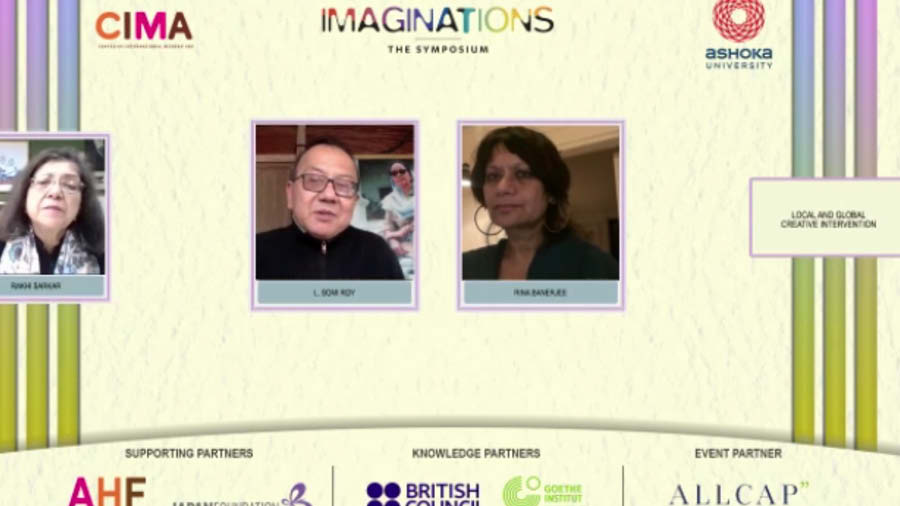
The director of CIMA, Rakhi Sarkar, in conversation with the panellists of the session ‘Local and Global Creative Intervention’
Taking the conversation on interventions and intersections forward was the session, Local and Global Creative Intervention, moderated by the director of CIMA, Rakhi Sarkar, who was in conversation with L. Somi Roy, curator and founder-managing trustee of Imasi: The Maharaj Kumari Binodini Devi Foundation, and Rina Banerjee, an artist and sculptor from New York. Focusing on how creating art is often a response to existing conditions, Sarkar engaged in a lively and probing conversation with the panelists about their ‘global and local’ artistic interventions during the years of the pandemic.
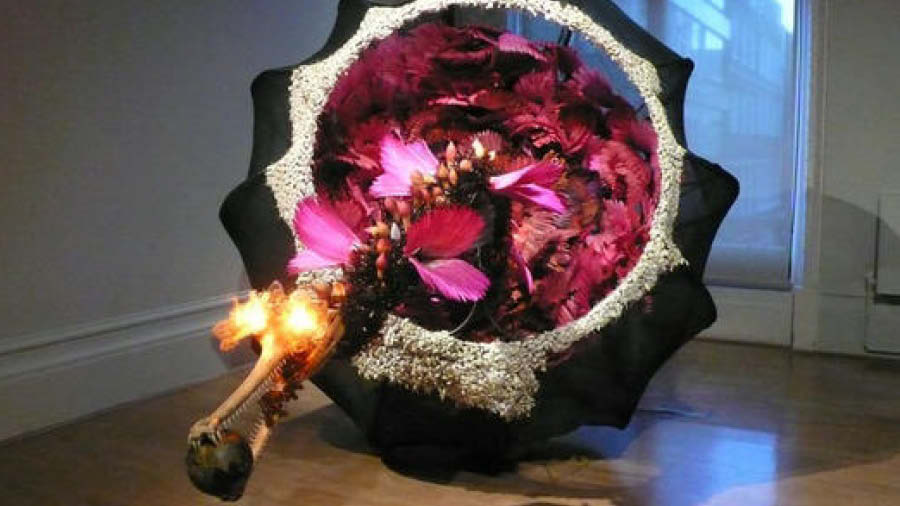
'The World As Burnt Fruit' by Rina Banerjee (shown as part of a presentation by the artist)
“How does one pursue one’s work during Covid years, if they were to continue?” wondered Banerjee, who did a Paris residency during the pandemic. “What has changed about the way artists produce work in the last 50 years is the idea of having a reach – being able to communicate where you are… but also the idea of culture as constant travel through the conduit of the human being. That means transporting yourself to other places where you can connect with the culture abroad. Covid has us trapped, but artwork should be resistant to containment.”
Roy, who joined the session from Manipur, reflected on how working on his late mother’s centenary through the pandemic months gave him the guidelines on what he should be pursuing. “For me, the whole point of cultural intervention starts with my mother, the author Binodini, and the quest to translate and publish her…. I have produced five books, two of which are translations of Binodini in a revived script called Meitei Mayek. One of the translations had to be launched as an e-book first owing to the first wave; could a Manipuri book get an e-market? I said yes, and proceeded to start a social media campaign to bring Binodini to the young generation.
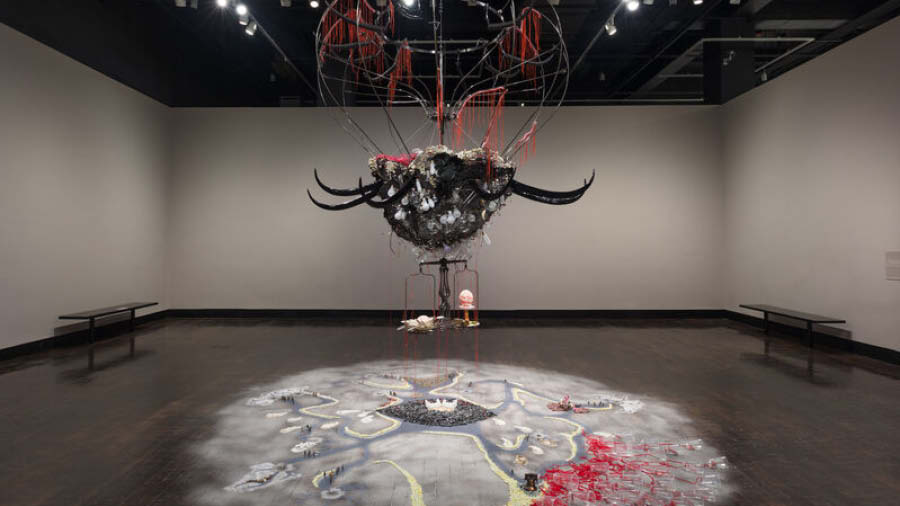
'A World Lost' by Rina Banerjee (shown as part of a presentation by the artist)
“There is a literature that predates writing,” observed Roy. “Literature was once told and heard.” It is important for us to locate those stories, he said, so that, in keeping with Sarkar’s sentiment, the local truly becomes the global.
Watch the second and third sessions here.
Blurring the boundaries of art
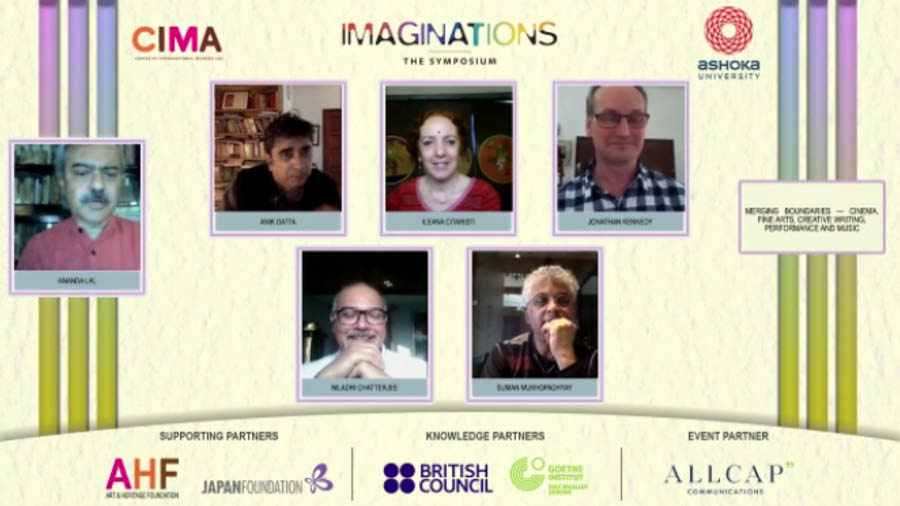
The theatre critic and Writers Workshop director, Ananda Lal, in conversation with the panelists of the session titled ‘Merging Boundaries — Cinema, Fine Arts, Creative Writing, Performance and Music’
The final session of Day 2 brought together renowned names in the creative fields for a discussion on Merging Boundaries — Cinema, Fine Arts, Creative Writing, Performance and Music. Interdisciplinary artistic performance is by no means new, observed theatre critic, author and director of Writers Workshop, Ananda Lal, who moderated the session. “But the primacy given to certain art forms owing to their fixed nature led to the academic misconception that they exist in demarcated territories.”
“Cinema, being the youngest of the art forms, has definitely had the opportunity to use and combine all the other forms,” agreed filmmaker Anik Dutta. “Literature informs script-writing and lyrics; music and dancing become core parts of mainstream Indian films.”
The Odissi and Chhau dancer, Ileana Citaristi, made an interesting connection between Indian and European forms of artistic training that aid in dissolving the boundaries of creative expression. “In the Grotowski system of training, the trainer guides an actor through the process of introspection, creating a relationship of absolute trust and reciprocal respect – very similar to the guru-shishya dynamic in India. For me, it was quite a discovery to see the similarities in the role of eastern dancer and western actor in transcending the temporal sphere and elevating the spectator to a subliminal state of existence.”
“Covid has had a material impact on how art is made and experienced,” observed Jonathan Kennedy, director of Arts at the British Council in India. “But think of Durga Puja; it’s astonishing to witness the intersection of art, retail, light design, tourism and so on. These artists are imperative to the sense of place, attraction and culture. Elsewhere, actors become playwrights, playwrights become dancers. It is, after all, collaborative – all these roles make up a theatre production. William Shakespeare was an actor first who also happened to write plays; perhaps that’s why he could write for actors and understand theatre-making.”
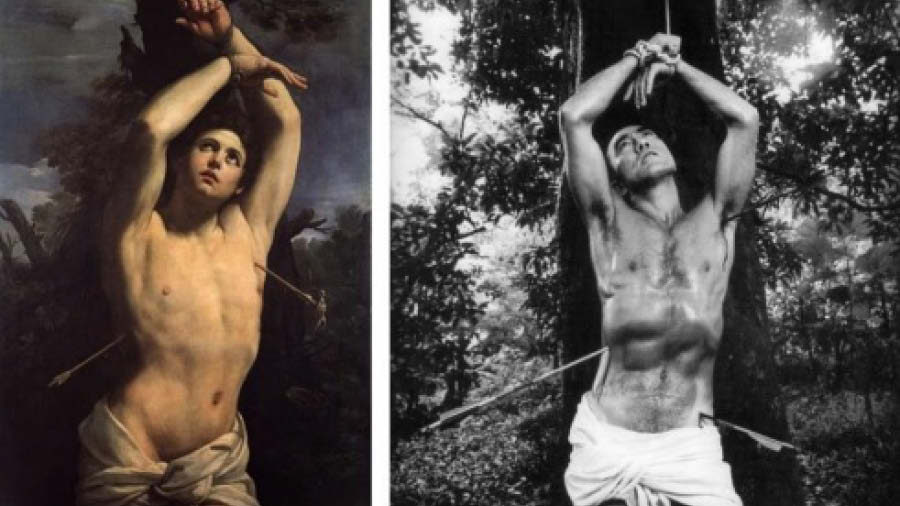
Yukio Mishima paying homage to Guido Reni’s ‘St. Sebastian’ in the 1960s — shown as part of a presentation by the panelist, Niladri Chatterjee, during the final session of Day 2 Photo: Kishin Shinoyama
Choosing the figure of St. Sebastian to illustrate the idea of the fading borders of art, Niladri Chatterjee, professor of English at the University of Kalyani, gave the audience an enlightening and entertaining visual presentation of the metamorphosis of the saint from being a sacred icon to a ‘profane’ figure – a transformation that drew in several artistic interventions. “As early as 1514, he begins to cross from the religious to the profane via a controversial painting made of him; by 1911, there’s a coalescing of writing, music and dance in relation to him, because Gabriele D’Annunzio writes a musical called Le Martyre de saint Sébastien, with music by Claude Debussy and choreography by Michel Fokine.”
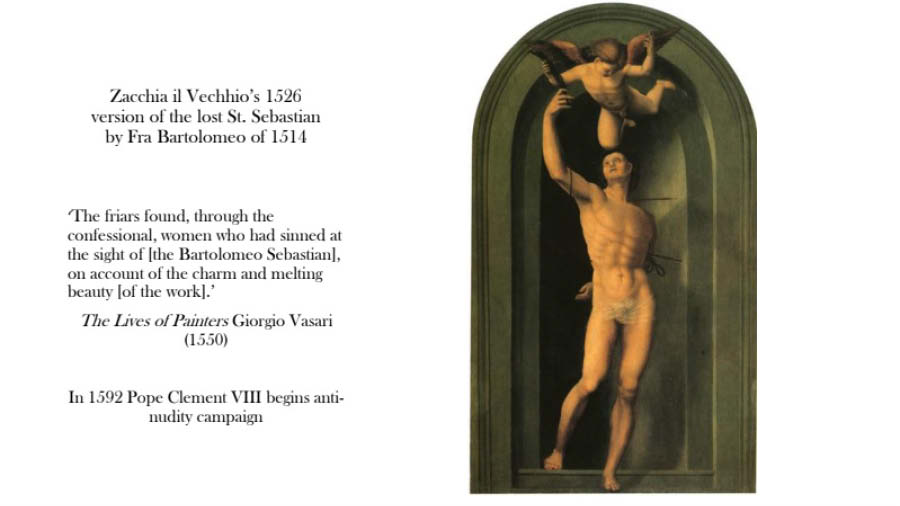
Zacchia il Vecchio’s 1526 version of the lost painting, 'St. Sebastian with an Angel', by Fra Bartolomeo — shown as part of Niladri Chatterjee's presentation
“Having worked in both theatre and cinema for 30 years, I get the essence of both the forms,” said the filmmaker and theatre director, Suman Mukhopadhyay. “But how is the multiplicity of experience being worked on and assimilated so that the artistic outcome can be organic? There must be awareness about multicultural and multidisciplinary exercises. Give performers the scope to be open. This exercise must happen all the time.”
The vastly different strands of the conversation and the delightful directions it took seemed to cement the notion of boundaries merging – an encouraging thought with which the symposium for 2022 came to an end.
Watch the session here.
